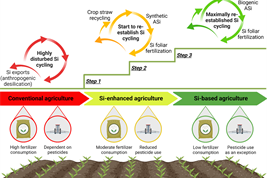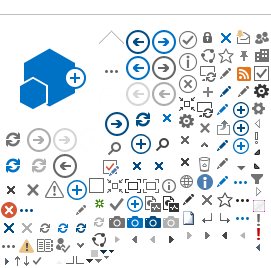09.12.2024
Press release

In a new study published in the Journal of Sustainable Agriculture Research, researchers led by the Leibniz Centre for Agricultural Landscape Research (ZALF) investigated the potential of so-called reactive silicon, which can be quickly absorbed by plants, for more sustainable agriculture. The results show that an agriculture based on optimal silicon supply could be better adapted to global change and climate change: In a system with sufficient levels of amorphous silicon in the soil, less phosphorus fertilizer and pesticides are needed and water retention in the soil is improved. The silicon absorbed by plants also protects them from harmful fungi and insects.
This is particularly due to the fact that silicon prevents the binding of phosphorus to soil elements and increases its availability for plants. Reactive silicon also supports water storage and availability in the soil. As a result, plants are less exposed to water stress during periods of drought and more stable yields can be achieved.
Reactive silicon differs from "normal" silicon primarily in its availability for plants. While silicon is very common in the earth's crust, it is usually bound in soils in unreactive, poorly soluble compounds, for example in the form of quartz or other silicates, which decompose very slowly and therefore hardly any silicon can be absorbed by plants.
Reactive silicon, on the other hand, is present in an amorphous, more easily water-soluble form, for example as amorphous silicate, which releases silicic acid that can be absorbed by plant roots. This form can be quickly incorporated into the plants' metabolism, improving nutrient uptake, water retention and resistance to stress factors such as drought and pests.
Reducing the use of pesticides through silicon enrichment
Additional silicon enrichment in the soil not only strengthens plants against drought stress. Silicon deposits in plant tissue also increase resistance to harmful fungi and insects. This is another argument in favor of silicon-based agriculture: plants are less stressed and more resistant to diseases due to the increased availability of nutrients and water, which means that fewer pesticides are needed, the authors of the study argue.
Transition to a silicon-rich agricultural system
Intensive agriculture has led to a significant decline in plant-available and amorphous silicon in many soils. In a transition phase, the content of amorphous silicon in the soil should be gradually increased, which can already lead to a reduction in the use of fertilizers and pesticides. In the long term, the model aims for an agricultural system with a high content of reactive silicon in the soil. By re-incorporating straw residues in the field, for example, this silicon content can then be kept constant, which can sustainably reduce the use of fertilizers and pesticides.
Need for research into long-term effects
The researchers emphasize that the long-term effects of silicon on agricultural production need to be investigated further. Initial indications suggest that silicon also leads to higher carbon storage in the soil. However, further long-term studies are needed to better understand the effects on the environment and the optimal application methods.
„"Our study shows that silicon can be a promising component for sustainable plant production. Through targeted research and integration into agricultural systems, silicon can help to stabilize yields and protect the environment at the same time," explains Prof. Jörg Schaller from ZALF, lead author of the study.
Project partner:
- Leibniz Centre for Agricultural Landscape Research (ZALF)
- University of Giessen
- Brandenburg University of Technology Cottbus
- University of Bonn
- Martin Luther University Halle-Wittenberg
Funding information:
The study was financed by ZALF.
Note on the text:
This is a summary of the original text created with the help of artificial intelligence: Schaller, J., Webber, H., Ewert, F., Stein, M., Puppe, D. (2024). Silicon-enhanced sustainable crop production. Journal of Sustainable Agriculture Research. DOI:
https://doi.org/10.1038/s44264-024-00035-z, published under license CC BY 4.0
https://creativecommons.org/licenses/by/4.0/. /. The text has been carefully reviewed and revised under the aspects of AI regulations at ZALF.
